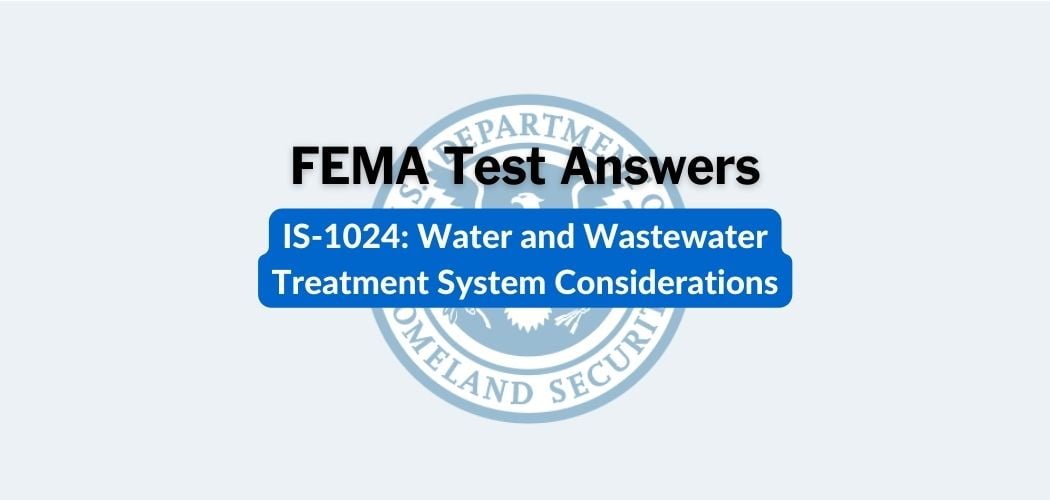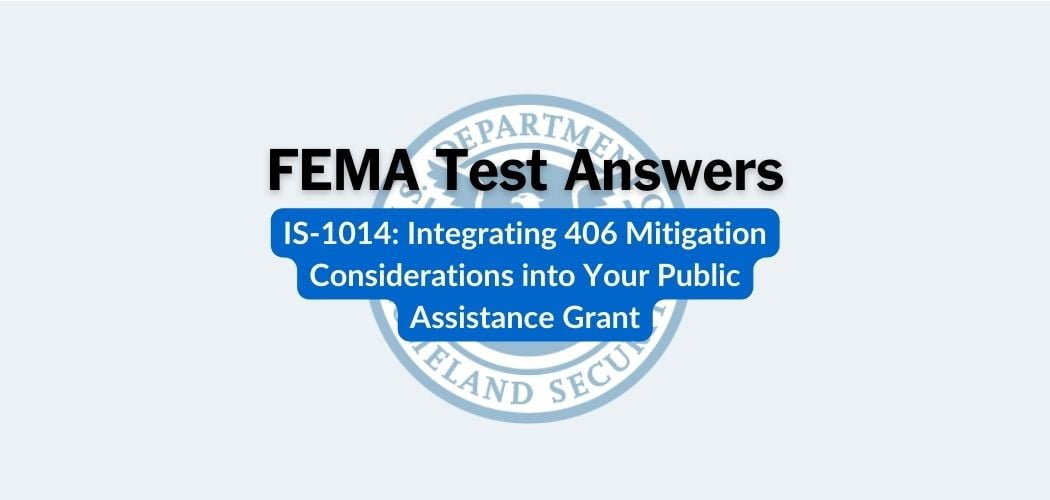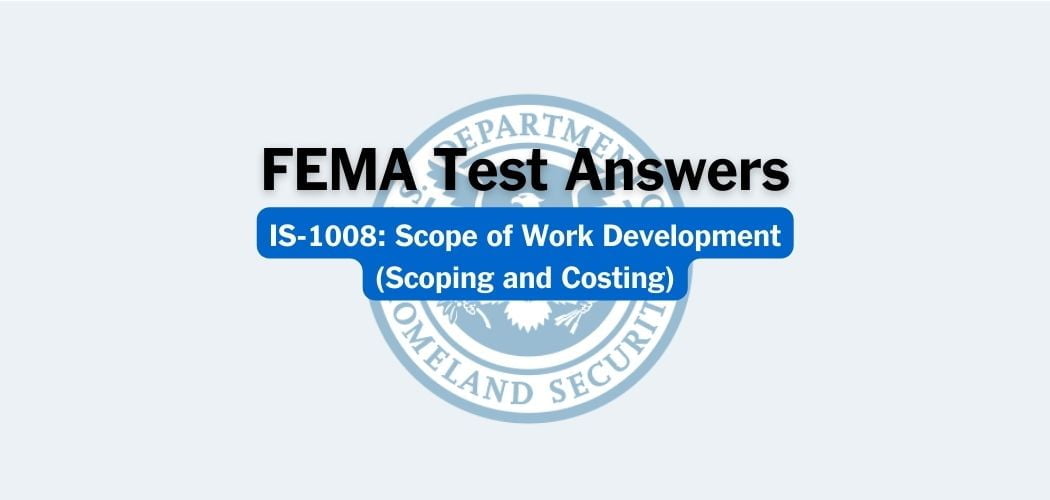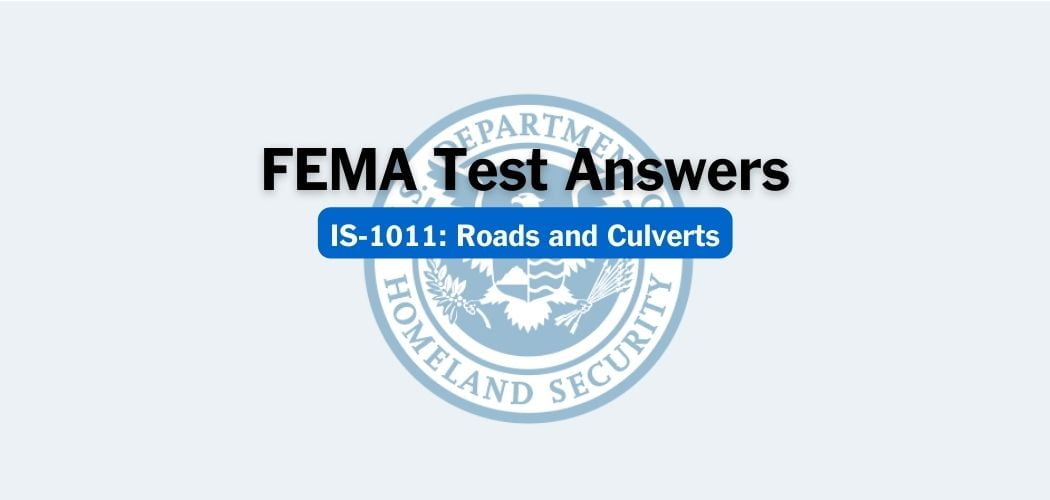Overview: The FEMA IS-321 was published on 10/31/2013 to train Hazard Mitigation Advisor Specialists to explain both the hurricane hazard and how to mitigate future damages effectively, to people affected by hurricanes.
NOTE: Each time the IS-321 final exam test is loaded, you will receive a unique set of questions and answers. The test questions are scrambled to protect the integrity of the exam.
FEMA IS-321 test answers
Question 1. Installing backflow valves is a dry floodproofing measure that prevents hurricane storm water or sewage from coming through a structure’s drainpipes after a flood from a hurricane.
A. TRUE✅
B. FALSE
Question 2. FEMA publications can be found at FEMA.gov and :
A. Federal Alliance for Safe Homes
B. HM Disaster Workforce Website✅
C. Institute for Building and Home Science
D. National Association of Home Builders
E. All of the above.
Question 3. Which FEMA-partner organization(s) below would you recommend to the public regarding mitigating damage from hurricanes?
A. Federal Alliance for Safe Homes
B. Institute for Building and Home Science
C. National Association of Home Builders
D. All of the above.✅
E. None of the above.
Question 4. Anchoring a shed with anchor straps can reduce wind damage to the shed and to other structures.
A. TRUE✅
B. FALSE
Question 5. Which is the best resource recommendation to give a member of the public about hurricane mitigation?
A. FEMA publications and websites relevant to the needs of that member of the public.✅
B. The list of websites provided by Google on “rebuilding after a hurricane”
C. A list of all FEMA publications that give explicit instructions for rebuilding after a hurricane.
D. The mitigation techniques that you used on your own home.
Question 6. The area on an NFIP Flood Insurance Rate Map which indicates coastal areas subject to inundation by the 1-percent-annual-chance flood event, with additional hazards associated with storm-induced waves, is called a:
A. T Zone
B. V Zone✅
C. Z Zone
D. None of these are correct.
Question 7. Which mitigation measure reduces the risk of damage by high hurricane winds to outbuildings?
A. Secure sheds with anchor straps similar to those used for manufactured homes.
B. Remove trees that are closer to the structure than the height of the trees at maturity.
C. Both of these are correct.✅
Question 8. Residential safe rooms built to the standards of FEMA 320: Taking Shelter from the Storm, provide near-absolute protection that reduces the risk of injury or death caused by the dangerous forces of extreme winds.
A. TRUE✅
B. FALSE
Question 9. Which statement about sand dunes and mangrove stands is consistent with NFIP regulations for V Zones?
A. A property owner may alter the sand dune or mangrove stand as needed because it is his/her property.
B. A property owner may only re-vegetate dunes to prevent erosion of the dunes.✅
C. Both of these are allowed by NFIP.
D. Neither of these is correct.
Question 10. Which mitigation measure below is an example of wet floodproofing?
A. Protecting appliances and utilities from flooding by raising them to Base Flood Elevation or higher.✅
B. Waterproofing a structure below Base Flood Elevation using a waterproof veneer.
C. Installing backflow valves on sewage lines
D. All of these are correct.
Question 11. There is no mitigation action that can help keep trees rooted during strong winds
A. TRUE
B. FALSE✅
Question 12. Which of the following NFIP requirements applies to structures located in an area designated on a Flood Insurance Rate Map as a V Zone?
A. The bottom of the lowest horizontal member is elevated above the Base Flood Elevation.✅
B. The lower area enclosures include the requirements of engineered breakaway walls.
C. Structural fill is banned.
D. All of the above apply
Question 13. Communities may add a “freeboard” requirement in the local floodplain ordinance to require structure elevation above the Base Flood Elevation in Special Flood Hazard Areas.
A. TRUE✅
B. FALSE
Question 14. If a community acquires a flood-prone residential property to meet NFIP requirements, that property can be redeveloped as a new housing project.
A. TRUE
B. FALSE✅
Question 15. Securing double entry doors with one latch at the top of the door will prevent the doors from being blown open by hurricane winds.
A. TRUE
B. FALSE✅
Question 16. Which mitigation measure below is an example of dry floodproofing?
A. Protecting appliances and utilities from flooding by raising them to Base Flood Elevation or higher.
B. Waterproofing a structure below Base Flood Elevation using a waterproof veneer.✅
C. Anchoring fuel tanks with straps and ground anchors.
D. All of these are correct.
Question 17. Direct the public to local building officials prior to repairing or rebuilding because most communities have building codes and/or ordinances that may be applicable.
A. TRUE✅
B. FALSE
Question 18. Hardening a structure by strengthening the continuous load path is an effective hurricane mitigation technique because:
A. The continuous load path connects the roof directly to the bottom floor of a structure, allowing it to withstand the force of hurricane winds.
B. By linking and reinforcing the structure’s connections from the roof to the foundation, the load caused by hurricane-force wind is transferred to the ground.✅
C. Metal brackets and straps link the structure’s components horizontally which keeps each of the building’s floors level when the structure is hit by strong winds.
D. All of these are correct.
Question 19. Which of the following should be considered before selecting flood control barriers to mitigate flooding?
A. Periodic maintenance is required to preserve effectiveness.
B. Local drainage may be affected by flood control barriers.
C. This method will not bring Substantially Improved/Damaged residences into compliance with the local floodplain ordinance.
D. All of the above.✅
Question 20. At a disaster, which organization is responsible for deciding what advice to provide to the public about mold?
A. US Public Health Service
B. FEMA
C. Environmental Protection Agency (EPA)
D. The State Health Department✅
Question 21. A V Zone on an NFIP Flood Insurance Rate Map is a coastal area subject to inundation by the 1-percent-annual-chance flood event with additional hazards associated with
A. Storm-induced waves✅
B. Levee failure.
C. Dam failure
D. All of the above are correct
Question 22. A gable roof cannot be reinforced by bracing the framing at the ends of the gable to make it more wind-resistant. Only a hip roof is hurricane-wind resistant.
A. TRUE
B. FALSE✅
Question 23. A continuous load path in a structure connects the roof to upper floor walls, upper walls to lower walls, lower walls to main floor, and main floor to foundation.
A. TRUE✅
B. FALSE
Question 24. Mold can be a health hazard but can not cause structural damage.
A. TRUE
B. FALSE✅
Question 25. Which roof type below is recommended because of its low-profile, wind-resistant design?
A. Gable roof
B. Hip roof✅
C. Neither type
Question 26. Flood mitigation measures that meet local floodplain management requirements for residences include floodproofing, elevating or relocating structures, water control barriers, and property acquisition.
A. TRUE✅
B. FALSE
Question 27. Which is the best recommendation for mitigating hurricane wind damage to shingles?
A. Use clay shingles in all wind hazard areas
B. Use shingles with a manufacturer’s warranty.
C. Use staples or adhesives liberally to connect the shingles to the roof sheathing.
D. Install shingles according to manufacturer recommendations and local building codes.✅
Question 28. Which mitigation measure below reduces the risk of damage to structures by wind-damaged trees?
A. Prune trees to allow the air to blow through the branches to help keep the tree rooted during strong winds.
B. Remove trees that are closer to the structure than the height of the trees at maturity.
C. Both of these are correct.✅
Question 29. Which of the following is an NFIP requirement applicable to a structure in a V Zone?
A. Structures can only be elevated and anchored using pilings.
B. The bottom of the lowest horizontal structural member of the building must be elevated above the Base Flood Elevation.✅
C. Space below the lowest floor can be solid as long as it doesn’t contain valuables.
D. All are NFIP requirements.
Question 30. What factors determine the size and quantity of connection brackets needed to secure the continuous load path?
A. Design loads and local building code requirements.✅
B. The type of materials that are being connected.
C. Both of these are correct
D. Neither of these is correct.
Question 31. Hazard Mitigation (HM) staff should distribute only the mold publications provided by the HM Community Education and Outreach.
A. TRUE✅
B. FALSE
Question 32. When asked by a member of the public about repairing structure damage from a hurricane, offer advice on mitigation measures, provide relevant FEMA resources, and:
A. Give specific repair directions.
B. Give a list of all websites about hurricanes.
C. Send the person to local building officials.✅
D. All of these are correct.
Question 33. Safe rooms also offer protection from flood waters; If a person has a safe room, they can ignore evacuation instructions.
A. TRUE
B. FALSE✅
Question 34. Reinforcing a garage door with metal bars and brackets will increase its resistance to high-wind pressure from hurricanes.
A. TRUE✅
B. FALSE
Question 35. Nails or screws designed for roofing applications, anchored in the underlying rafter or truss according to building codes, enhance the stability of the roof sheathing.
A. TRUE
B. FALSE✅
Question 36. Using impact-resistant glass and functional shutters can not reduce the risk of wind damage to windows.
A. TRUE
B. FALSE✅
Other Hazard Mitigation answers
This module is one in a series of Independent Study modules for the Hazard Mitigation disaster workforce, which addresses appropriate basic mitigation information for public consumption regarding earthquakes, floods, hurricanes, tornados, and wildfires.



